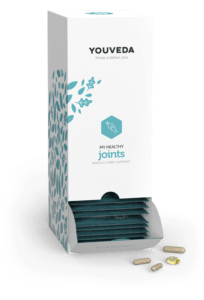Pops, crackles, clicks, creaks – the sounds of your joints bubbling as you move may be absolutely harmless! However, as we (inevitably) age, it is important to continue moving our joints in their full motion. You know the saying – if you don’t use it, you lose it! Understand how Maintaining the health of your joints is easier than you think.
The freedom to move is something we often take for granted; but for some, it is a daily struggle and considered a luxury. Much of our quality of life depends on mobility. The strength and flexibility of our joints and muscles also influence our sense of inner freedom.

What is a Joint?
There are a couple different types of joints, which are spaces in our bodies where two bones connect, meaning a lot of connective tissue is happening. The joints we think about most often are synovial joints, which are moveable and supple, such as the knees, hips, elbows, shoulders and fingers.
However, there are more joints in our body that are not as widely known, like the cartilaginous and fibrous joints found in the skull and the pelvis, which barely move at all!
Still, what are all of these connective tissues doing in our joints? Here are a few of types of connective tissues found:
Collagen – a type of tissue that serves as the main structure for the joint
Tendons – collagen fibers that connect bones to muscles
Ligaments – soft tissue that connects bones to bones. Joints that are super moveable like the shoulder have fewer ligaments than a joint like the elbow, which is less moveable, but more stable
Cartilage – absorbs shock so our bones don’t clank together
Synovial fluid – lubricates the joints, kind of like a “joint oil”
What Happens to Joints as we Age?
Most of the time, when our joints like our knuckles and knees crack, there is nothing to worry about. Those popping sounds is the releasing of nitrogen bubbles that were trapped in synovial fluid.
However, as we age, joint movement may become stiffer due to less “joint oil” and thinning cartilage. Also, ligaments may become shorter and less flexible. All of these reasons may make your body feel a little bit more wooden and impliable. Who wants that?! And how do we prevent this from happening?!
The Importance of Movement
You know the feeling when you stand up after a long car ride or sitting at a desk all day? Tight, sore, stiff, tired. Lack of movement shrinks our cartilage and stagnates our synovial fluid. We want to keep everything in motion – moving!
As we age, our bones lose calcium and other minerals. Also, the change in hormones may affect our bones (menopause). Strong bones and strong muscles play big role in maintaining healthy joints.
How to Maintain Joint Health
Nobody wants arthritis, osteoporosis, osteoarthritis, weakness, pain, or any sort of discomfort for that matter! In order to maintain proper joint health, here are a few easy ideas to incorporate into your daily routine:
- Warm up before your exercises to increase circulation and lubricate your joints — simple jumping jacks, jogging in place, and stretches should suffice.
- Build strength in your muscles to support your joints — try lifting weights, or hold your own weight in plank pose, lunges or pull ups.
- Create a low impact hobby — walk, jog, swim, pilates or yoga.
- Drink more water — Water makes up 80 percent of your cartilage.
- Massages and body rolling — help get those fluids moving around in your body.
- Yoga — practice poses to move your joints in their full motion.
- Weight — maintain a healthy weight so there is less pressure on your joints.
- Increase core strength — helps with moving your body in every way.
- Stay positive — if it seems painful or challenging to workout everyday, be sure to try new things until you find something that is fun and works for you. Modify your workouts and dwell in those post-workout endorphins!
- Take a supplement, like YouVeda’s My Healthy Joints which includes boswellia, curcumin, giner and laksha guggul which help promote joint mobility and magnesium, L-phenylalanine and coenzyme Q10 to provide crucial nutrients for bone and joint health.
Of course, our spine is very important, bringing messages from our brain to all of our body parts and helping us stand up straight and tall. Here are a couple yoga poses to practice daily (it shouldn’t take more than 5 minutes!) to keep your spine supple and strong:
- Cat / cow tilts
- Supine twists
- Bridge
- Pelvic tilts
We hope that your joints remain healthy for your whole life, and you find some simple techniques to keep your joints working painlessly and properly!
Shop the Story: My Healthy Joints
Author – Carolyn Gladd (YouVeda Wellness Contributor)





